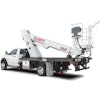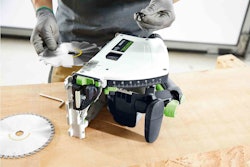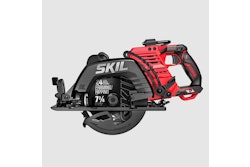Every type of concrete cutting tool has a unique application to which it is uniquely suited. By understanding the finer points of each type of saw in your rental inventory, employees will be able to make the best suggestions to your customers, resulting in the most successful rentals. Following are profiles of three very popular rental saws.
Cut-off machines
Q: What is a cut-off machine and what does it do?
A cut-off machine is a hand-held two-stroke machine used to cut concrete, asphalt and metal. A cut-off machine uses either a composite resin abrasive wheel or a diamond wheel to cut concrete, asphalt and metal in various construction applications, explains Adam Hanks, product manager at Stihl Inc.
Q: How does it differ from other types of concrete saws?
There are many types of concrete saws, from walk-behind floor saws to wall saws and diamond wire saws, just to name a few, says Hanks. "Cut-off machines differ from these other types of concrete-cutting equipment mainly because they are hand-held and can be used for a variety of applications. Most other concrete-cutting equipment is designed for specific applications."
Q: What are the most important things for a rental business to consider when selecting a cut-off machine?
Hanks says one of the most important considerations is reliability. When a cut-off machine is down for maintenance, the rental house is losing money by not having the machine available for rent. A cut-off machine should be reliable enough to stand up to the rigors of construction work, but be very easy to service when the need arises. Spare parts should also be readily available from the manufacturer.
Q: Are there any tips rental businesses can provide customers to get the best performance from a cut-off machine?
There are several things customers should be aware of when renting a cut-off machine. First and foremost, advise them to have the proper personal protective equipment for the job they're doing, Hanks says. Next, be sure customers have the right wheel for the job. "Many diamond and abrasive wheels are designed for a particular application and using a wheel for a job it's not designed for can cause damage to the cut-off machine. When cutting concrete, a customer should always use water to reduce the amount of concrete dust in the air and help cool the wheel in the cut," he advises. "Finally, always use good-quality, name-brand fuel and engine oil in the cut-off machine. Remember, most of the units are two-cycle engines, so the fuel and oil must be mixed."
Q: Is there anything customers should be advised against doing with a cut-off machine?
"Never use carbide-tipped, wood-cutting or circular saw blades on cut-off machines. These blades can cause severe personal injury from reactive forces, blade contact or thrown objects," Hanks says. "Never cut wood of any type with a cut-off machine. Always use the correct personal protective equipment when operating a cut-off machine, even for a short time. Don't take shortcuts with personal safety just to save time. Never operate a cut-off machine without first reading the manufacturer's instruction manual, which should be available at time of rental."
Q: How can cut-off machines be best maintained for longest life?
"Again, good-quality, name-brand fuel is one key to better engine life. A high-quality, two-cycle engine oil should also be used in the correct ratio for the particular cut-off machine being used," Hanks says. "Customers should be reminded that the fuel and oil need to be mixed in the correct ratio for these units to run properly. Because of the abrasive nature of concrete dust, we recommend that the air filters on cut-off machines be replaced, not cleaned. Concrete dust can cause the filter element to wear if it is blown or shaken out, which will allow dust into the cylinder and could damage the engine. Follow the manufacturer's recommended maintenance procedure for air and fuel filters."
Q: In general, how long does it take a rental business to realize its full return on investment from a cut-off machine, assuming optimum utilization?
Hanks concludes, "There are several factors that affect the return on investment for cut-off machines, including the time in the rental fleet, the utilization, the cost of maintenance and how much the rental house charges to rent the equipment. In general, the return on investment for a cut-off machine is approximately less than one year."
Concrete chainsaws
Q: What is a concrete chainsaw and what does it do?
A concrete chainsaw is a tool designed like a wood-cutting chainsaw with a power head, guidebar and chain which is driven by a sprocket from the power head around the guidebar, explains Bill Bray, vice president of sales and marketing at ICS, Blount Inc. With a concrete chainsaw, the chain incorporates diamond segments that are laser welded to the chain in place of the cutting teeth typical with a wood saw. The diamond segments, like on a traditional circular diamond blade, essentially create a grinding action that wears away the concrete, brick or other aggregate material. This grinding action creates a very safe cutting operation with none of the kickback that is associated with a wood chain.
Q: How does it differ from other types of concrete saws?
A concrete chainsaw has several advantages over the traditional circular-blade cut-off saws, says Bray. "The chainsaw is designed to actually plunge nose first into the material and has the ability to cut a minimum of 2X+ a 14-inch circular blade. The smallest ICS gas saw allows a full 10-inch deep cut, and depending on the saw model, there are gas saws that can cut a full 16-inch depth," Bray says.
A gas saw with a 12-inch depth of cut is the most common in rental companies. There are hydraulic concrete chainsaws that can cut to a 25-inch depth. A 14-inch circular blade on a cut-off saw is designed for a maximum depth of slightly less than five inches.
"Because a concrete chainsaw uses a guidebar with a long narrow flat surface, the saw can provide a deeper cut with no overcut, allowing the operator to make square corners. This is not possible with a circular blade," Bray says. "Concrete chainsaws not only cut deeper with no overcuts, but they can be used to make openings as small as 4"x4"xthe cutting depth of the bar. They are also useful in creating odd-shaped cuts in material."
Q: What are the most important things for a rental business to consider when selecting a concrete chainsaw?
"First, does the rental company have customers who need to cut openings deeper than five inches? If the answer is yes, then a concrete chainsaw is the right tool," says Bray. "Most rental companies begin with a gas-driven two-cycle engine, as it offers portability and a lower initial investment." ICS recommends at least an 80cc engines which can use either a 12- or 14-inch cutting-depth guidebar. If the rental company has contractors with significant cutting needs, they might want to consider a hydraulic concrete chainsaw, which has more power and can utilize guidebars for openings up to 25 inches. The hydraulic saw does require a separate hydraulic power supply capable of providing 8 gpm of flow at 2,000 psi.
Q: Are there any tips rental businesses can provide customers to get the best performance from a concrete chainsaw?
"They should always start a cut by plunging the nose of the bar into the aggregate material first and then using the leverage of the bar to cut either up or down," explains, Bray. "They should also advise the customer not to over-tighten the chain against the bar. The chain should move freely around the bar by hand so as not to rob cutting speed and power. The operator should first make a shallow cut with the nose along the cut line to create a straighter cut. For depths greater than 15 inches, it is recommended to step cut the opening with a shorter bar and chain first."
Q: Is there anything customers should be advised against doing with a concrete chainsaw?
Bray says a concrete chainsaw must have at least 20 psi of water hooked to the saw. The saw cannot cut dry.
In gas saws, it is also critical to have the correct oil to gas fuel mixture. As a concrete chainsaw runs at a much heavier load than circular-blade cut-off saws, it is strongly recommended that the oil to fuel mixture be 25:1, twice the amount of oil when compared to other two-stroke engine applications. Improper fuel mixture will cause the heat created by the load to prematurely wear and/or seize the engine piston.
"Concrete chainsaws will cut through rebar, but the bar should be encased in concrete and not cut as exposed pieces." Bray notes.
Q: How can concrete chainsaws be best maintained for longest life?
"They should be thoroughly cleaned to remove all concrete slurry from the saw, particularly the starter pawls, and then sprayed with a penetrating lubricant," Bray says. "The air filter in a gas saw should be checked and clean. Check the drive sprocket and guidebar for wear. They should be replaced after every two to three chains."
Q: In general, how long does it take a rental business to realize its full return on investment from a concrete chainsaw, assuming optimum utilization?
"Depending upon the rental rate, a concrete chainsaw should provide a 100-percent return on investment in nine rentals," states Bray. "On the most popular sized rental saw, the 80cc gas saw with a 12-inch cutting depth guidebar and chain, the typical rental rate for the saw and bar is $85 per day with the customer paying as low as $195 for outright purchase of the chain. For nine rentals, this would equate to $2,520 of rental revenue, while the cost of the saw and consumables to support the nine rentals would be less than $2,500. The ROI increases significantly after the ninth rental."
Tile Saws
Q: What is a tile saw and what does it do?
A Tile Saw is designed for cutting tile and stone. All tile saws use wet-cutting blades for specific application of porcelain, thin-bodied tile and stone. "Tile Saws are easy to maintain and to rent," notes Brian Delahaut, vice president with MK Diamond Products. "They can be used for setting tile and also for small masonry jobs with the right blade."
Q: How does it differ from other types of saws?
The tile saw is a very precise saw. Most tile saws have a linear tracking system to ensure precision during the cut. Tile saws use continous-rim blades to ensure a very smooth cut. Other saws use segmented blades or turbo blades for cutting masonry materials. Masonry saws and tile saws operate in the same manner.
Q: What are the most important things for a rental business to consider when selecting a tile saw?
"The warranty period," Delahaut states.
Q: Are there any tips rental businesses can provide customers to get the best performance from tile saw?
"They should always use the right blade for the best cut," says Delahaut.
Q: Is there anything customers should be advised against doing with a tile saw?
Delahaut says tile saws can do most any type of cutting.
Q: How can tile saws be best maintained for longest life?
"Make sure that the saw is always well lubricated and always clean," Delahaut says. "Make sure that the blade is of a good quality for the best results of customer satisfaction and cutting performance."
Q: In general, how long does it take a rental business to realize its full return on investment from a tile saw, assuming optimum utilization?
"Generally the ROI is about six to eight months, depending on the number of rentals and the rental rate charged," says Delahaut. "Tile saws have traditionally been the third or fourth most-rented product next to carpet cleaners and floor sanders. These saws can generate a significant ROI beyond the initial investment in very quick order."
Delahaut adds, "The ROI should be in the charge for the blade. If the customer is only going to rent the saw for one or two days, then the blade should be included in the rental. If the saw is going to be used more than two days, then the blade should be sold to the customer. Most of the rental stores don't have a selection of blades available to the customer, thus forcing the customer to purchase the blade from another distributor. Tile blades will generate as much as 60 to 70 percent margin if sold to those customers that intend to use the saw for major work.
"A good tile blade should get at least 10 to 15 rentals before being replaced. That's about $4 per rental. Rental stores need to be sure to build this cost into their price. A well-maintained saw that is clean will also attract a higher rental rate. If a customer is going to rent the saw for more than two weeks, it's best to sell him a new saw,"




















